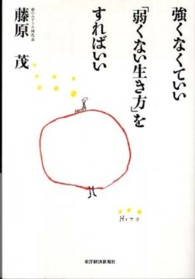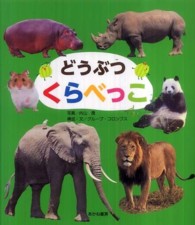- ホーム
- > 洋書
- > 英文書
- > Cinema / Film
Full Description
Examines Western-inspired fashion objects in Japanese cinema between 1923 and 1939
Consults varied primary Japanese-language source material, such as visual analysis of extant films; film fragments and stills from the era; advertising ephemera such as film posters and match boxes; and various print-based materials
Provides film analysis and synopses of many Japanese films which are not yet commercially available and/or subtitled in English
Concentrates equally on depictions of menswear and womenswear there is currently a bias towards depictions of women's styles in both fashion and film studies
Discusses the history of issues highly relevant to today's media climate in a non-American and non-European context
Presents fashion as a means of coding identities both on- and off-screen case studies include the Modern Girl (the Japanese variant of the Hollywood flapper), the Modern Boy (a foppish masculine archetype), the modernising Japanese housewife and the healthy sportsperson.
Discusses LGBT identities and the usage of fashion to depict them in both Japanese and Hollywood cinemas
Film and Fashion in Japan, 1923-39 examines the interaction between the audience member and Japan's film and fashion industries, focusing on Western-inspired fashion objects as opposed to indigenous Japanese items. Taking an interdisciplinary approach, Barnett examines the semiotics of dress onscreen within Japan's transcultural media climate, consulting not only film- or fashion-related theoretical bases but also historical and gender-based approaches.
The work consults surviving films, print media and advertising materials, allowing insights into lost films and the period's thriving commercial context. It focuses on the expressive Modern Girl image (the Japanese equivalent of the Hollywood flapper); sportswear and hybridised dress styles (which combined Japanese and Western-influenced aesthetics) and their relationship with body; and menswear in the early work of the director Ozu Yasujir?. This book discusses the role of fashion consumption in defining emergent modern identities and their relationships with new spaces, questioning their arising in the Japanese context and within the global sphere.
Contents
Introduction: Defining, Theorising and Approaching Japanese Film, Fashion and Modernity
Part 1 - On Sartoriality and Speaking: 'Expressive' Women and Western Attire
1.1 - Fashionable female imagery between media formats: Tanizaki Jun'ichirō's Naomi (1924) and the concept of marketable female star "types"
1.2 - Sartoriality and Expressivity Pre- and Post- Sound: The Vernacular Voice, The Western-Attired Woman and the City
1.3 - Fashion Commodities Onscreen:the Modern Housewife in Naruse Mikio's No Blood Relation (Nasanu Naka, 1932) and Masculine Female Attire in Ozu Yasujirō's Dragnet Girl (Hijōsen no onna, 1933)
Part 2 - Sportswear and Hybridity: The National Body and Gender
2.1 - Sportswear and Hybridity: The Middle-Class Housewife as Hybridised Consumer Archetype
2.2 - Women and the Sporting Body
2.3 - Men and the Sporting Body
Part 3 - Menswear and the Modern Boy: Ozu Yasujirō and Western Style for Men
3.1 - Historically Contextualising Japanese Male Fashion: Western-style Menswear, the Cinema and Space
3.2 - Opposition to Western-style Menswear and the Desire for "Authentic" Japanese Male Commercial Identity Archetypes:Shōchiku's shōshimin eiga and Ozu's commercially augmented everyday male life onscreen
3.3 - Was Ozu a "Modern Boy"? Negotiating Related Sartorial Archetypes
Book Conclusion
Reference List
Filmography








